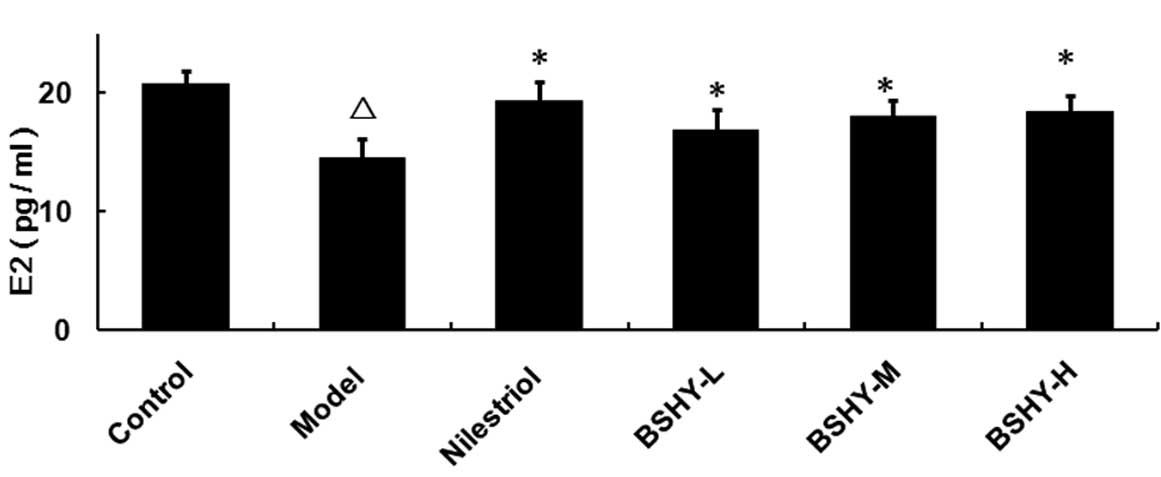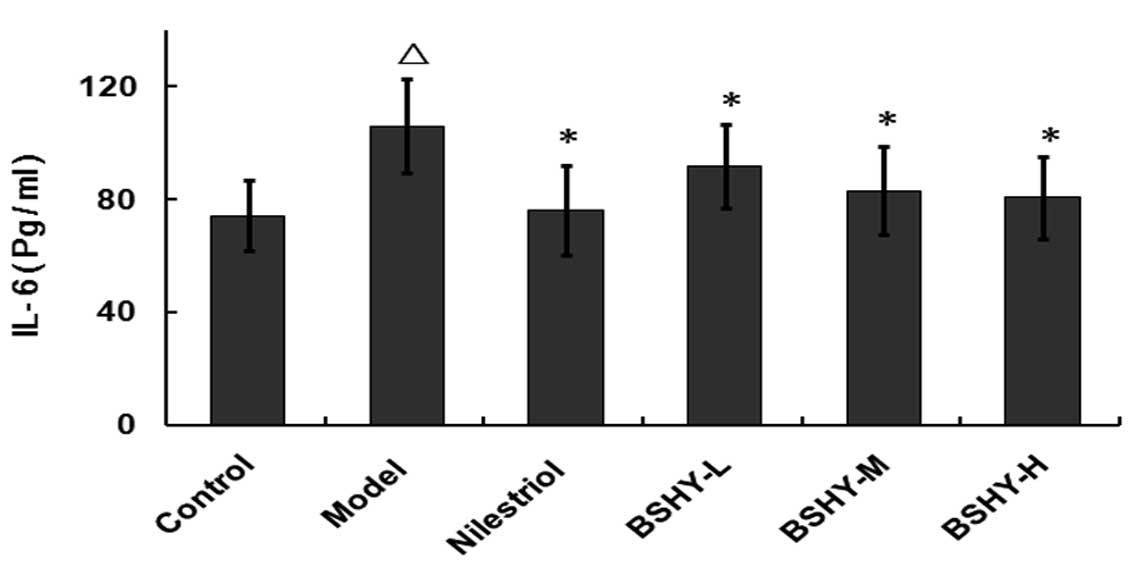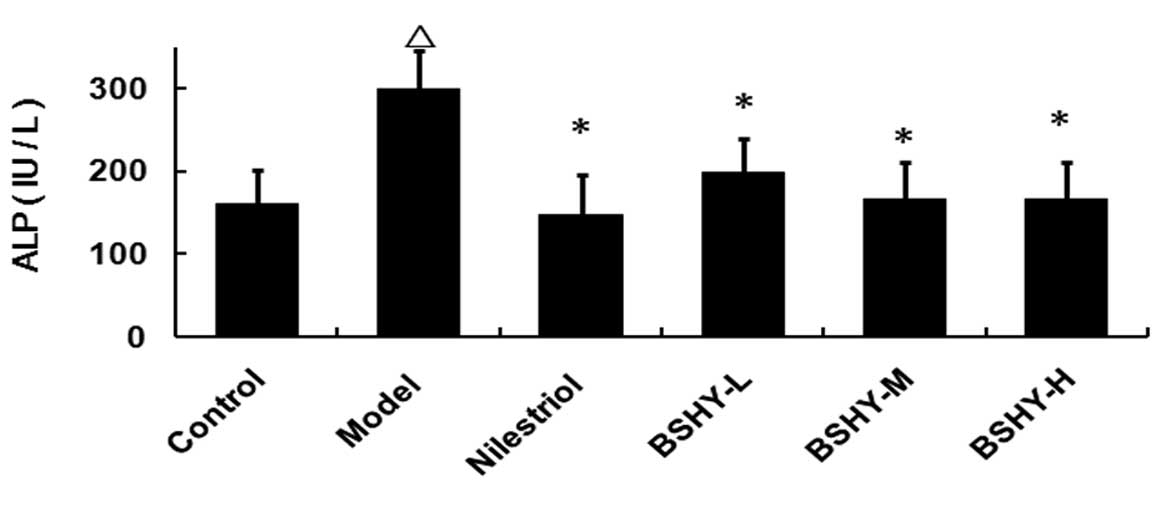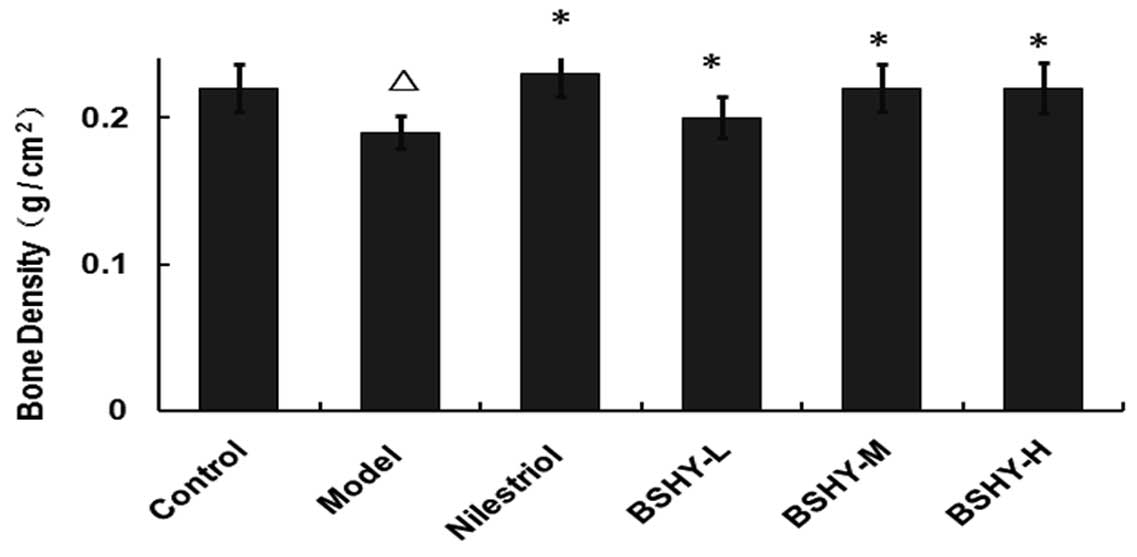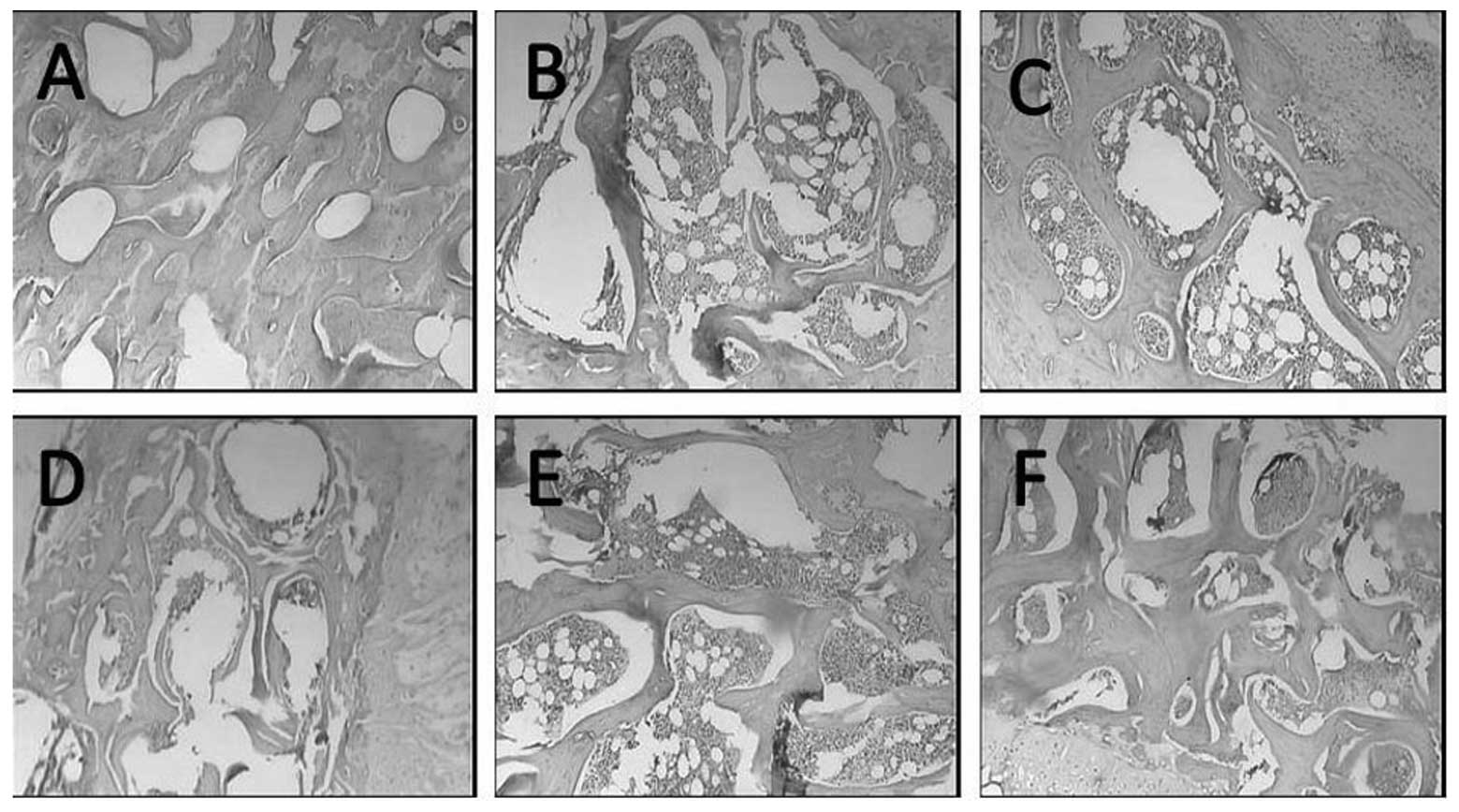Article
Treatment effect of Bushen Huayu extract on postmenopausal osteoporosis in vivo
- Authors:
- Lu Ouyang
- Qiufang Zhang
- Xuzhi Ruan
- Yibin Feng
- Xuanbin Wang
-
View Affiliations / Copyright
Affiliations:
Laboratory of Chinese Herbal Pharmacology, Renmin Hospital, Hubei University of Medicine, Shiyan, Hubei 442000, P.R. China, Laboratory of Chinese Herbal Pharmacology, Renmin Hospital, Hubei University of Medicine, Shiyan, Hubei 442000, P.R. China, Basic School of Medicine, Hubei University of Medicine, Shiyan, Hubei 442000, P.R. China, School of Chinese Medicine, LKS Faculty, The University of Hong Kong, Hong Kong, SAR, P.R. China
-
Pages:
1687-1690
|
Published online on:
April 2, 2014
https://doi.org/10.3892/etm.2014.1661
- Expand metrics +
Metrics:
Total
Views: 0
(Spandidos Publications: | PMC Statistics:
)
Metrics:
Total PDF Downloads: 0
(Spandidos Publications: | PMC Statistics:
)
This article is mentioned in:
Abstract
Bushen Huayu extract (BSHY), a traditional Chinese medicine, has been demonstrated to treat postmenopausal osteoporosis, however, the underlying mechanism remains to be fully elucidated. The aim of the present study was to investigate the therapeutic effect of BSHY and the mechanisms underlying this effect in an in vivo postmenopausal osteoporosis animal model. A total of 1 g BSHY containing 7.12 µg icariin was prepared. Low‑dose BSHY (BSHY‑L; 11.1 g/kg), medium‑dose BSHY (BSHY‑M; 22.2 g/kg) and high‑dose BSHY (BSHY‑H; 44.4 g/kg) was administered to oophorectomized rats using intragastric infusion. Estradiol (E2), interleukin‑6 (IL‑6) and serum alkaline phosphatase (ALP) levels, as well as bone density, were determined. It was found that the levels of serum ALP in the BSHY‑L, BSHY‑M and BSHY‑H groups (197.75±41.74, 166.63±44.83 and 165.63±44.90 IU/l, respectively) were significantly decreased compared with the model group (299.13±45.79 IU/l; P<0.05), whilst the levels of E2 (16.89±1.71, 17.95±1.40 and 18.34±1.43 pg/ml, respectively) increased compared with the model group (14.54±1.61; P<0.05). In addition, the levels of IL‑6 decreased in the BSHY‑L, BSHY‑M and BSHY‑H groups (91.85±14.81, 82.99±15.65 and 80.54±14.61 pg/ml, respectively) compared with the model group (105.93±16.50 pg/ml; P<0.05). Furthermore, it was demonstrated that BSHY increased the bone density in the BSHY‑L, BSHY‑M and BSHY‑H groups (0.20±0.014, 0.22±0.016 and 0.22±0.017 g/cm2, respectively) compared with the model group (0.19±0.011 g/cm2; P<0.05). BSHY was also found to increase the number of osteoblasts in the BSHY‑L, BSHY‑M and BSHY‑H groups (25.38±2.17, 29.25±2.12 and 30.00±2.39, respectively), compared with in the model group (14.75±2.38; P<0.05), and decrease the number of osteoclasts in the BSHY‑L, BSHY‑M and BSHY‑H groups (4.00±1.85, 4.25±1.39 and 5.75±1.49, respectively) compared with 9.50±1.60 observed in the model group (P<0.05). These results suggest that BSHY is a potential therapeutic drug for the treatment of osteoporosis in vivo. Furthermore, these results suggest that the mechanism by which BSHY decreases the serum levels of IL‑6 may be by regulating E2.
View References
|
1
|
Cavalli L and Brandi ML: Age- and
gender-related macro- and micro-architecture changes in bone
structure and implications for treatment. Int J Clin Rheumatol.
6:359–369. 2011. View Article : Google Scholar
|
|
2
|
Lindsay R: Hormones and bone health in
postmenopausal women. Endocrine. 24:223–230. 2004. View Article : Google Scholar : PubMed/NCBI
|
|
3
|
Sanders S and Geraci SA: Osteoporosis in
postmenopausal women: considerations in prevention and treatment:
(women’s health series). South Med J. 106:698–706. 2013.
|
|
4
|
Yoldemir T, Erenus M and Durmusoglu F: The
impact of serum FSH and estradiol on postmenopausal osteoporosis
related to time since menopause. Gynecol Endocrinol. 28:884–888.
2012. View Article : Google Scholar : PubMed/NCBI
|
|
5
|
Ouyang L, Wang X, Li H and Xiao Y:
Determination of Icariin in Bushenhuayu Electuary by HPLC. Zhong
Guo Yao Shi. 13:13–15. 2010.(In Chinese).
|
|
6
|
Joo MK, Park JJ, Lee BJ, Kim JH, Yeon JE,
Kim JS, Byun KS and Bak YT: The effect of a proton pump inhibitor
on bone metabolism in ovariectomized rats. Mol Med Rep.
7:1267–1272. 2013.PubMed/NCBI
|
|
7
|
Rachner TD, Khosla S and Hofbauer LC:
Osteoporosis: now and the future. Lancet. 377:1276–1287. 2011.
View Article : Google Scholar : PubMed/NCBI
|
|
8
|
Craft CS, Broekelmann TJ, Zou W, Chappel
JC, Teitelbaum SL and Mecham RP: Oophorectomy-induced bone loss is
attenuated in MAGP1-deficient mice. J Cell Biochem. 113:93–99.
2012. View Article : Google Scholar : PubMed/NCBI
|
|
9
|
Kwak EJ, Lee YS and Choi EM: Effect of
magnolol on the function of osteoblastic MC3T3-E1 cells. Mediators
Inflamm. 2012:8296502012.PubMed/NCBI
|
|
10
|
Wang M, Ling G, Bei X, Junqing C, Peiqing
Z and Jie H: Clinical observation on 96 cases of primary
osteoporosis treated with kidney-tonifying and bone-strengthening
mixture. J Tradit Chin Med. 25:132–136. 2005.PubMed/NCBI
|
|
11
|
Hsieh TP, Sheu SY, Sun JS and Chen MH:
Icariin inhibits osteoclast differentiation and bone resorption by
suppression of MAPKs/NF-κB regulated HIF-1α and PGE(2) synthesis.
Phytomedicine. 18:176–185. 2011.PubMed/NCBI
|
|
12
|
McLean RR: Proinflammatory cytokines and
osteoporosis. Curr Osteoporos Rep. 7:134–139. 2009. View Article : Google Scholar
|
|
13
|
Mysliwiec J, Adamczyk M, Nikolajuk A and
Gorska M: Interleukin-6 and its considerable role in the
pathogenesis of thyrotoxicosis-related disturbances of bone
turnover in postmenopausal women. Endokrynol Pol. 62:299–302.
2011.PubMed/NCBI
|
|
14
|
Wang Y, Li LZ, Zhang YL, Zhu YQ, Wu J and
Sun WJ: LC, a novel estrone-rhein hybrid compound, concurrently
stimulates osteoprotegerin and inhibits receptor activator of NF-κB
ligand (RANKL) and interleukin-6 production by human osteoblastic
cells. Mol Cell Endocrinol. 337:43–51. 2011.PubMed/NCBI
|
|
15
|
Eastell R, Reid DM, Vukicevic S, Ensrud
KE, LaCroix AZ, Thompson JR, Thompson DD and Cummings SR: Effects
of 3 years of lasofoxifene treatment on bone turnover markers in
women with postmenopausal osteoporosis. Bone. 50:1135–1140.
2012.PubMed/NCBI
|
|
16
|
Song Y, Li SH, He ZJ, Zhang YW and Zhou
MW: Effect of icariin on osteoporosis in ovariectomized female
rats. Jun Yi Jin Xiu Xue Yuan Xue Bao. 33:400–403. 2012.(In
Chinese).
|
|
17
|
Yang L, Lu D, Guo J, Meng X, Zhang G and
Wang F: Icariin from Epimedium brevicornum Maxim promotes the
biosynthesis of estrogen by aromatase (CYP19). J Ethnopharmacol.
145:715–721. 2012. View Article : Google Scholar : PubMed/NCBI
|
|
18
|
Zhang S, Liu X, Zheng S, Jiang M, Xin C,
Lu X, Li F and Xiong Z: Metabonomic study on protective effect of
ethanol extracts of drynariae rhizoma on osteoporosis in rats urine
by using UPLC-MS/MS. Zhongguo Zhong Yao Za Zhi. 37:658–662.
2012.(In Chinese).
|















